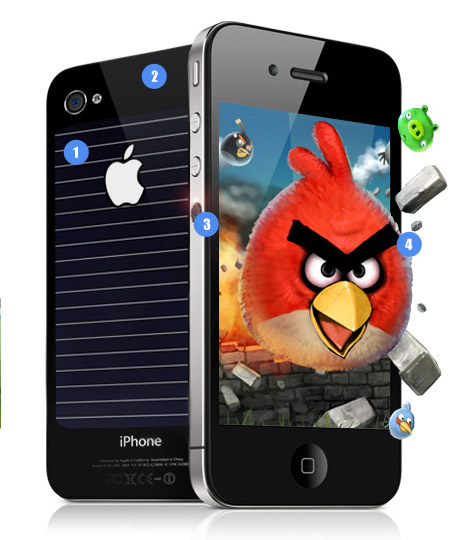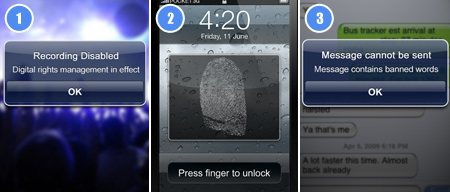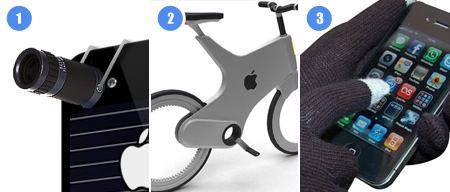What would the iPhone 5 look like if Apple used all of its patents?
Patently absurd, to be frank

Apple is sitting on hundreds upon thousands of patents. The Cupertino company that brings you a new pearly white gadget or two each year has its hands on endless protected ideas and inventions.
Some are handy for scaring off competitors who steer too close to Apple's designs (that's you, Samsung) and others are filed to aggressively compete in the dog-eat-dog smartphone mega industry. And the rest are so mad they'll never see the light of day.
But what if Apple actually made use of its legally protected ideas, and threw every design, feature, and piece of software that they've patented into the next iteration of the iPhone?
Well, it'd look a little something like this, we reckon.
 Hardware
Hardware
Introducing the new iPhone 5, designed by digging into Apple's mountainous pile of patents and protected ideas. At first glance, it might look like an iPhone 4 that's been hastily hacked up in Photoshop, but look more carefully and you might find a few surprises.
1) Solar-powered caseApple has a whole mess of patents relating to solar power, and has come up with plenty of ways to harness the sun's rays to power everything from a giant MacBook to a teensy iPhone.
If Apple ever went through with it, it probably wouldn't actually look like a solar panel on the front or back. In a 2008 patent, Apple described how an iPhone could catch some rays without any visible panels or cells.
By sandwiching a matrix of solar cells between the LCD and touchscreen components of the screen, Apple would enable you to charge your gadget up whenever you're using it under the sun. Not that you can ever see the bloody thing in direct sunlight.
2) Electronic door keyAt this rate, your smartphone will be the only thing you need to carry in your pocket. It's slowly usurping your wallet, and if a 2010 Apple patent is anything to go by, your keys are on the hit list, too.
Should this patent ever come to fruition, you would be sealing your doors electronically and plonking a panel next to your door. No more fumbling about with a key and lock (that's so 4,000 years ago, guys). You rock up, type a code on your iPhone, and then swipe the device over the panel to open up.
Near Field Communication (NFC) technology - which is rumoured to appear in the real iPhone 5 and forms the basis of electronic money transfer - would power the whole deal. You could also set it so an alarm is sounded or the police are called if the wrong code is entered.
3) Built-in pico projectorEarlier this year, Apple applied for a patent that would see tiny projectors implanted in upcoming iPhones and iPads.
Using its own brand of "hybrid laser" technology, the iOS gizmo could spit out photos, videos, and games to a nearby wall through a tiny pinhole in the phone / tablet's side.
There are a few devices out on the market that have built-in projectors. But, they're mostly rather dire, either giving the gadget a bulky Nostradamus-style hump or projecting low-resolution, dim images. If there's one company that could get it right, though, it's Apple.
4) Glasses-free 3D display
Apple has its fingers in lots of pies, but it won't release any product until it's absolutely perfect. Except Final Cut Pro X. Not sure what happened there.
So, while the Nintendo 3DS is gallivanting around with a glasses-less 3D screen, and a couple of glasses-free 3D smartphones from LG and HTC are floating about, Apple has been carefully working on the technology and filing the necessary patents, rather than rushing a 3D iPhone to market.
Apple definitely doesn't want to sell a pair of iGlasses, so it would use domed pixels to project the left and right images to your eyes at all times. And because your head might not always been straight-on, 3D head-tracking technology would use a camera to follow your face to ensure a smooth and continuous three-dimensional image on-screen.
New iOS features 1) Real-world DRM for the camera
1) Real-world DRM for the camera
An Apple patent from 2011 toys with the idea of using infrared hubs in real-world locations to send data to your iPhone. Point your phone at an Aztec vase in a museum, Apple posits, and historical data about the item pops up on your screen.
But the nifty trick comes with far more sinister connotations. The patent explicitly mentions using the infrared hub as a kill switch that would stop the camera app from taking pictures or entering record mode in certain locations.
Like real-world DRM, it could prevent your recording a band's performance at a gig or taking photos of copyrighted objects in a shop. It's all a little Orwellian for our tastes.
2) Biometric security and personalisation
You hold a lot of data in your body that can be used to exclusively identify you: from fingerprints to teeth, hair strands to bodily fluids. For Apple, it's your thumbprint, your heartbeat, and your voice that it wants to harness.
From a 2005 patent, the Cupertino firm suggests using biometric sensors on the bits of a handheld gadget that your thumbs rest against to instantly recognise who's holding it. This would let you sign in to your iPhone or let the iPhone queue up your personal settings.
In 2010, Apple won a patent that could identify a user by measuring the unique electrical activity signature in the phone holder's heart. As soon as they hold the phone, and as long as their heart is beating, the iPhone's electrocardiography (or EKG) sensor would know who it is, and let them log in.
And finally, while Apple currently uses voice technology to let you call your mum or play all songs by Daft Punk, you could one day use your dulcet tones to leap past the Lock screen. Just by barking at your iPhone, the built-in voice recognition tech would know whether or not it's you before unlocking the OS.
3) Anti-sexting technology
When Apple's former CEO Steve Jobs famously declared, "If you want porn, get an Android", he really meant it. A seemingly innocuous SMS patent is all about keeping naughty words out of text messages.
Once the option is turned on (which parents might want to do before handing the phone to their little ones), objectionable words like 'bum' and 'fanny' would set off an internal alarm and stop the text from being sent.
It could even let the profanity-laden and vulgarity-filled message be sent to a responsible adult, so they can dole out the appropriate punishment. If you like, the system could also be used for educashional purposes, like not letting teens send out texts with shoddy grammar.
Accessories 1) Magnetic zoom lens
1) Magnetic zoom lens
This patented accessory, from 2010, would actually be rather handy if it ever came into being. Apple has submitted plans for a zoom lens gadget that would clip onto your iPhone or iPod touch to improve the magnification of the device's camera.
Apple put forward a number of different ways that the added accessory could attach itself to an iPhone - including mechanical fastenings, tiny metal clips, or even velcro - but reckons that the miracle of magnets would work best.
The patent also shows that other devices, including speakers and medical sensors, could clip on in the same way to add extra functionality to your device if and when you require it.
2) The iBike
Last year, one of Apple's most zany patents came to the surface. The so-called iBike is an accessory for cyclists that records data - e.g. cycling speed, distance travelled, time, altitude, incline, decline, and more - for your records.
Then, like the Nike+ gemstone that you smuggle in your running shoes, the iBike would communicate this data to your iPhone, so you can monitor your cycling prowess in a variety of handy apps.
3) The iGlove
When it comes to the wacky world of patents, Apple has thought of everything, even including using your iPhone in the frigid temperatures of an Arctic winter without having to remove your mittens and risk some nasty frostbite.
The "high tactility glove" accessory has thick insulating layers to keep your pinkies warm and an exposed liner that isn't as warm, but does work on an iPhone touchscreen. Simply peel back the outer shell to half-expose your fingers to the elements and use your gadget.
It's a rather complicated system, but no doubt Apple would milk it for all its worth and sell the iGlove with a hefty fanboy tax on top.
